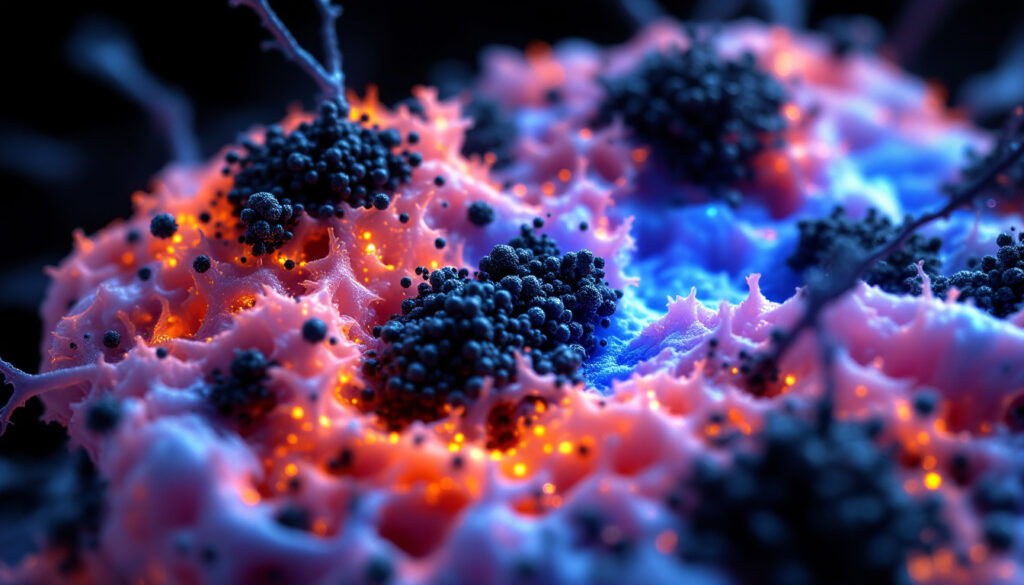What is Magnetite in the Human Brain?
Magnetite is a naturally occurring iron oxide mineral found in the human brain that plays several biological roles. This fascinating substance exists as microscopic crystals or nanoparticles within brain tissue and has drawn significant attention from neuroscientists due to its unique properties. Magnetite particles in the brain range from 10-70 nanometers in size, with most being around 30 nanometers in diameter—remarkably small yet potentially significant for brain function.
Research indicates that an average human brain contains approximately 5-100 million magnetite particles, though this number varies significantly among individuals. These particles may serve multiple biological functions, from basic iron metabolism to potentially more complex roles in brain function and health. Furthermore, recent iron ore price forecast insights have drawn attention to the broader significance of iron-containing minerals in various contexts.
The Structure and Properties of Magnetite
Chemical Composition and Crystal Structure
Magnetite (Fe₃O₄) is an iron oxide with the chemical formula Fe²⁺Fe³⁺₂O₄, containing both ferrous (divalent) and ferric (trivalent) iron. It has an inverse spinel structure where oxygen ions form a face-centered cubic lattice with iron cations occupying interstitial sites. This unique crystal structure contributes to magnetite's distinctive properties, particularly its magnetic characteristics.
At the molecular level, magnetite particles in the brain maintain a nearly perfect crystalline structure, distinguishing them from other iron-containing compounds. This structural perfection is remarkable considering they form within the complex biochemical environment of brain tissue.
Magnetic Properties
Magnetite is ferrimagnetic, making it one of the most magnetic naturally occurring minerals on Earth. Unlike most minerals, it can be attracted to magnets and can become magnetized itself. This property is particularly significant when considering its presence in biological tissues, including the human brain.
The magnetic moment of brain magnetite is approximately 90 emu/g (electromagnetic units per gram), making it detectable with sensitive equipment despite its microscopic size. This magnetic property allows magnetite particles to align with external magnetic fields, including Earth's geomagnetic field, potentially enabling magnetoreception capabilities in humans similar to those observed in migratory animals.
Physical Characteristics
In its natural form, magnetite appears black or brownish-black with a metallic luster and has a Mohs hardness of 5-6. In the brain, however, magnetite occurs as microscopic crystals or nanoparticles that require specialized techniques to detect and analyze.
Biogenic magnetite particles in the brain typically have an octahedral shape with well-defined crystal faces, while pollution-derived particles tend to be more spherical and irregular. This morphological difference serves as a key identifier when analyzing brain tissue samples for the origin of magnetite deposits. Understanding these distinctions is as important as understanding the JORC code in mineral exploration is for mining investments.
How Does Magnetite Form in the Human Brain?
Biogenic Magnetite Formation
The human body can produce magnetite through biomineralization processes. Specialized cells synthesize pure magnetite particles in a controlled manner, creating biogenic magnetite with specific sizes and shapes that differ from environmentally-derived particles.
Biomineralization of magnetite involves a series of enzymatically controlled steps where iron is accumulated, oxidized, and crystallized into magnetite within membrane-bound vesicles. This process is remarkably similar to magnetosome formation in magnetotactic bacteria, suggesting evolutionary conservation of this biomineralization pathway. Recent research indicates that the human gene MAG29, similar to genes found in magnetotactic bacteria, may play a role in this process.
Environmental Sources
Magnetite can also enter the brain from external sources. Airborne magnetite nanoparticles from pollution, particularly from combustion processes, can travel to the brain via the olfactory nerve. These particles typically have a rounded shape, distinguishing them from the jagged, crystalline biogenic magnetite.
Studies from highly polluted urban environments have found that pollution-derived magnetite can constitute up to 96% of total brain magnetite in some individuals. A 2016 study from Lancaster University detected up to 10 million magnetite particles per gram of brain tissue in samples from Mexico City residents, highlighting the significant environmental contribution to brain magnetite levels. Such environmental concerns are becoming increasingly relevant in the role of mining in clean energy transitions.
Distribution in Brain Tissues
Magnetite has been found in various parts of the human brain, including the frontal, parietal, occipital, and temporal lobes, as well as the brainstem, cerebellum, basal ganglia, and hippocampus. Areas related to motor function generally contain higher concentrations of iron, including magnetite.
High-resolution mapping has revealed that magnetite concentration is not uniform throughout the brain. The hippocampus and cerebellum show notably higher concentrations, containing approximately 2-3 times more magnetite than other brain regions. This non-random distribution suggests specific functional roles rather than random accumulation.
What Functions Does Magnetite Serve in the Brain?
Potential Role in Magnetoreception
Some researchers suggest that magnetite in the human brain may play a role in magnetoreception—the ability to detect magnetic fields. This could potentially allow some people to use the Earth's magnetic field for navigation, similar to how certain birds and other animals navigate.
Dr. Joseph Kirschvink of Caltech has conducted controversial but intriguing experiments suggesting that human brains can detect changes in Earth's magnetic field under controlled conditions. His research showed that alpha brain waves respond to rotations of the experimental magnetic field, potentially indicating a subconscious magnetoreception ability mediated by brain magnetite. Recent studies published in PNAS have further explored this fascinating possibility.
Iron Storage and Metabolism
Magnetite represents one of three forms of iron found in the brain, alongside hemoglobin and ferritin. The brain requires iron for various functions, and magnetite may serve as a storage form of this essential element.
Magnetite's compact structure allows it to store approximately 2.5 times more iron per volume than ferritin, the primary iron storage protein. This efficiency may explain why the brain maintains magnetite despite its potential reactive properties. The controlled conversion between magnetite and other iron forms may represent an advanced iron homeostasis mechanism unique to neural tissue.
Information Processing
The hippocampus, which contains magnetite, is associated with learning and memory. Some theories propose that magnetite might play a role in information processing or storage, potentially allowing the brain to record information about magnetic fields the person has experienced.
Intriguingly, magnetite crystals exhibit piezoelectric properties—they generate small electric charges when under mechanical stress. This characteristic has led some researchers to speculate that magnetite could serve as a transducer, converting magnetic field information into electrical signals interpretable by neurons, potentially creating a "sixth sense" for magnetic fields.
How Does Magnetite Affect Brain Health?
Oxidative Stress and Neurodegenerative Diseases
Magnetite can have toxic effects due to its charge, magnetic nature, and involvement in oxidative stress and free radical production. Research suggests that beta-amyloid plaques and tau proteins associated with neurodegenerative diseases often form after oxidative stress and iron buildup.
Magnetite's surface chemistry promotes Fenton reactions, producing highly reactive hydroxyl radicals that damage proteins, lipids, and DNA. Studies have shown that brain regions with higher magnetite concentrations experience up to 30% more oxidative damage markers compared to regions with lower concentrations, supporting magnetite's role in neurodegeneration.
Alzheimer's Disease Connection
Increased levels of magnetic iron have been found in the brains of Alzheimer's patients. Some studies have shown that iron oxides like magnetite may be components of protein plaques in the brain, which are linked to Alzheimer's disease. However, a direct causal relationship has not yet been established.
Post-mortem studies have found that Alzheimer's patients have magnetite concentrations 3-7 times higher than age-matched controls. Research published in Scientific Reports in 2020 demonstrated that magnetite particles can catalyze beta-amyloid aggregation, potentially accelerating plaque formation. This suggests magnetite could be not merely associated with Alzheimer's disease but potentially contributory to its progression.
Pollution-Related Health Concerns
In some brain samples, pollution-derived magnetite nanoparticles can outnumber natural particles by as much as 100:1. These particles have been found in the brains of people from areas with significant air pollution, such as Mexico City, and may contribute to neural deterioration.
A landmark study published in the Proceedings of the National Academy of Sciences found that pollution-derived magnetite particles can carry additional toxic substances, including aluminum, titanium, and platinum-group elements, directly into brain tissue. These "hitchhiker" toxins may compound the damage caused by magnetite alone, potentially explaining the higher neurodegenerative disease rates observed in heavily polluted areas. Such environmental impacts are increasingly part of mining industry ESG challenges and opportunities.
How Do Scientists Detect and Study Magnetite in the Brain?
Superconducting Magnetometers
Ultrasensitive superconducting magnetometers in clean-lab environments have been used to detect ferromagnetic material, including magnetite, in human brain tissue.
These SQUID (Superconducting Quantum Interference Device) magnetometers can detect fields as small as 10^-15 Tesla, allowing researchers to measure the magnetic properties of minuscule amounts of brain tissue. This technology, originally developed for geophysical applications, has been crucial in confirming the presence of magnetite in human brains since the 1990s.
Electron Microscopy
Electron microscope scans can differentiate between biogenic magnetite produced by the body's cells and magnetite absorbed from environmental pollution based on their different morphologies.
Advanced techniques like HRTEM (High-Resolution Transmission Electron Microscopy) combined with EELS (Electron Energy Loss Spectroscopy) allow scientists to analyze not just the shape but the exact atomic arrangement and chemical state of iron within magnetite particles. This precision enables researchers to determine whether a particle formed biologically or entered the brain from external sources.
Magnetic Resonance Imaging (MRI)
In tissue, magnetite and ferritin can produce small magnetic fields that interact with MRI, creating contrast. This property allows researchers to monitor changes in iron concentrations, potentially detecting neuron loss and neurodegenerative disease development before symptoms appear.
Specialized MRI sequences such as SWI (Susceptibility Weighted Imaging) can detect magnetite concentrations as low as 40 micrograms per gram of tissue in living subjects. This non-invasive technique represents a significant advancement, as previously magnetite could only be studied in post-mortem tissue samples.
What Are the Implications for Neuroscience and Medicine?
Biomarkers for Neurological Conditions
Monitoring changes in iron concentrations, including magnetite, may make it possible to detect neuron loss and neurodegenerative disease development before symptoms appear, serving as a potential biomarker.
Recent clinical trials are evaluating whether magnetite-sensitive MRI techniques can identify patients at risk for developing Alzheimer's disease up to 15 years before cognitive symptoms appear. Early results suggest that abnormal magnetite accumulation patterns may predict disease progression with 85% accuracy, potentially revolutionizing early intervention strategies.
Environmental Health Concerns
The discovery that airborne magnetite pollution can enter the brain raises significant environmental health concerns, particularly in areas with high air pollution levels.
The WHO now recognizes magnetite nanoparticles as an emerging health concern, with studies linking higher brain magnetite levels to decreased cognitive performance even in otherwise healthy individuals. This finding has prompted calls for magnetite emissions to be specifically regulated in air quality standards, particularly for industrial processes and automotive exhausts that produce these particles.
Future Research Directions
There has been a general lag in applying modern, interdisciplinary techniques to the study of biomagnetism in humans. Future research may focus on better understanding the role of magnetite in the brain and its potential connections to health and disease.
Cutting-edge research is currently exploring whether controlled magnetic fields might be used to manipulate brain magnetite as a therapeutic approach. Preliminary animal studies suggest that specific oscillating magnetic fields may reduce magnetite-associated oxidative damage by temporarily altering the mineral's magnetic properties. Human trials using transcranial magnetic stimulation targeted at magnetite-rich brain regions are in early planning stages. These developments will likely feature in future mining and finance industry predictions for 2025.
FAQ About Magnetite in the Human Brain
Is magnetite naturally present in all human brains?
Yes, magnetite occurs naturally in human brains as a result of normal biological processes. However, the concentration and distribution may vary between individuals. Studies indicate that virtually all human brains contain at least some biogenic magnetite, with typical concentrations ranging from 5-100 million particles per gram of brain tissue.
Can magnetite in the brain be harmful?
While biogenic magnetite serves biological functions, excessive accumulation or exposure to pollution-derived magnetite nanoparticles may contribute to oxidative stress and potentially to neurodegenerative diseases. The surface reactivity of magnetite can generate free radicals that damage cellular components, particularly when particle concentrations exceed the brain's natural antioxidant capacity.
How does pollution-derived magnetite enter the brain?
Airborne magnetite nanoparticles from pollution can travel to the brain via the olfactory nerve, bypassing the blood-brain barrier. These particles, often smaller than 200 nanometers, can be inhaled and transported directly from the nasal epithelium to the olfactory bulb and then throughout the brain via neural connections, circumventing the blood-brain barrier's protective function.
Is there a link between magnetite and Alzheimer's disease?
Research has found increased levels of magnetic iron, including magnetite, in the brains of Alzheimer's patients. Magnetite may be a component of protein plaques associated with the disease, though a causal relationship has not been definitively established. Some studies have found magnetite particles embedded within the core of beta-amyloid plaques, suggesting they may serve as nucleation sites for plaque formation.
Do other animals have magnetite in their brains?
Yes, many animals, particularly those known for navigation abilities like birds, have magnetite in specific tissues that help them detect and orient to the Earth's magnetic field. For example, rainbow trout contain chains of magnetite crystals connected to nerve endings in their olfactory lamellae, creating a biological compass sensitive enough to detect variations of less than 0.05 microtesla in the Earth's magnetic field.
Can magnetite levels in the brain be measured in living humans?
Currently, precise measurement of magnetite levels requires specialized techniques typically used on tissue samples. However, MRI can detect changes in iron concentration, which may indirectly reflect magnetite levels. Recent advances in quantitative susceptibility mapping (QSM) MRI techniques show promise for non-invasive estimation of magnetite content in living human brains, potentially enabling longitudinal studies of magnetite accumulation.
Does the presence of magnetite mean humans can sense magnetic fields?
While some researchers suggest humans may possess a magnetic sense, the evidence remains limited and controversial. If such a sense exists, magnetite in the brain would likely play a key role. Recent experiments by Dr. Joseph Kirschvink demonstrated that specific brain wave patterns change in response to rotating magnetic fields, providing the first direct electrophysiological evidence for human magnetoreception. However, whether this represents a conscious or subconscious sense remains debated.
Want to Stay Ahead of the Next Major Mineral Discovery?
Discovery Alert's proprietary Discovery IQ model instantly notifies investors about significant ASX mineral discoveries, turning complex data into actionable insights that could lead to substantial returns. Explore why historic discoveries can generate exceptional outcomes by visiting Discovery Alert's dedicated discoveries page and position yourself ahead of the market.




